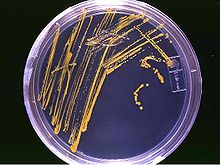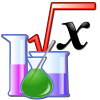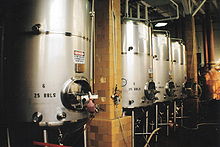- Microbiology
-
Microbiology (from Greek μῑκρος, mīkros, "small"; βίος, bios, "life"; and -λογία, -logia) is the study of microorganisms, which are defined as any microscopic organism that comprises either a single cell (unicellular), cell clusters or no cell at all (acellular).[1] This includes eukaryotes, such as fungi and protists, and prokaryotes. Viruses[2] and prions, though not strictly classed as living organisms, are also studied. Microbiology typically includes the study of the immune system, or Immunology. Generally, immune systems interact with pathogenic microbes; these two disciplines often intersect which is why many colleges offer a paired degree such as "Microbiology and Immunology".
Microbiology is a broad term which includes virology, mycology, parasitology, bacteriology, immunology and other branches. A microbiologist is a specialist in microbiology and these related topics.
Microbiological procedures usually must be aseptic, and use a variety of tools such as light microscopes with a combination of stains and dyes, agar plates in petri dishes, biochemical test and running tests against particular growth conditions. Specific constraints apply to particular fields of microbiology, such as parasitology, which heavily utilizes the light microscopy, whereas microscopy's utility in bacteriology is limited due to the similarity is many cells physiology. Indeed, most means of differentiating bacteria is based on growth or biochemical reactions. Virology has very little need for light microscopes, relying on almost entirely molecular means. Mycology relies on all technologies the most evenly, from macroscopy to molecular techniques.
Microbiology is actively researched, and the field is advancing continuously. It is estimated that only about one percent of the microorganisms present in a given environmental sample are culturable[3] and the number of bacterial cells and species on Earth is still not possible to be determined, recent estimates indicate that it can be extremely high (5 Exp 30 cells on Earth, unknown number of species). Although microbes were directly observed over three hundred years ago, the precise determination, quantitation and description of its functions is far to be complete, given the overwhelming diversity detected by genetic and culture-independent means.
Contents
History
Ancient
The existence of microorganisms was hypothesized for many centuries before their actual discovery. The existence of unseen microbiological life was postulated by Jainism which is based on Mahavira’s teachings as early as 6th century BCE.[4] Paul Dundas notes that Mahavira asserted existence of unseen microbiological creatures living in earth, water, air and fire.[5] Jain scriptures also describe nigodas which are sub-microscopic creatures living in large clusters and having a very short life and are said to pervade each and every part of the universe, even in tissues of plants and flesh of animals.[6] The Roman Marcus Terentius Varro made references to microbes when he warned against locating a homestead in the vicinity of swamps "because there are bred certain minute creatures which cannot be seen by the eyes, which float in the air and enter the body through the mouth and nose and there by cause serious diseases."[7][citation needed]
In 1546 Girolamo Fracastoro proposed that epidemic diseases were caused by transferable seedlike entities that could transmit infection by direct or indirect contact, or even without contact over long distances.[citation needed]
However, early claims about the existence of microorganisms were speculative, and not based on microscopic observation. Actual observation and discovery of microbes had to await the invention of the microscope in the 17th century.
Modern
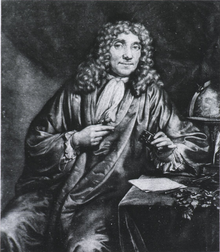 Antonie van Leeuwenhoek, is considered to be the first to observe microorganisms using a microscope.
Antonie van Leeuwenhoek, is considered to be the first to observe microorganisms using a microscope.
In 1676, Antonie van Leeuwenhoek observed bacteria and other microorganisms, using a single-lens microscope of his own design.[1] While Van Leeuwenhoek is often cited as the first to observe microbes, Robert Hooke made the first recorded microscopic observation, of the fruiting bodies of molds, in 1665.[8] The first observation of microbes using a microscope is generally credited to the Dutch draper and haberdasher, Antonie van Leeuwenhoek, who lived for most of his life in Delft, Holland. It has, however, been suggested that a Jesuit priest called Athanasius Kircher was the first to observe micro-organisms.[9] He was among the first to design magic lanterns for projection purposes, so he must have been well acquainted with the properties of lenses.[9] One of his book contains a chapter in Latin, which reads in translation – ‘Concerning the wonderful structure of things in nature, investigated by Microscope. Here, he wrote ‘who would believe that vinegar and milk abound with an innumerable multitude of worms.’ He also noted that putrid material is full of innumerable creeping animalcule. These observations antedate Robert Hooke’s Micrographia by nearly 20 years and were published some 29 years before van Leeuwenhoek saw protozoa and 37 years before he described having seen bacteria.[9]
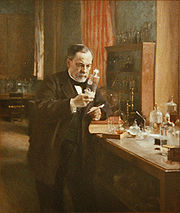 Innovative laboratory glassware and experimental methods developed by Louis Pasteur and other biologists contributed to the young field of bacteriology in the late 19th century.
Innovative laboratory glassware and experimental methods developed by Louis Pasteur and other biologists contributed to the young field of bacteriology in the late 19th century.
The field of bacteriology (later a subdiscipline of microbiology) was founded in the 19th century by Ferdinand Cohn, a botanist whose studies on algae and photosynthetic bacteria led him to describe several bacteria including Bacillus and Beggiatoa. Cohn was also the first to formulate a scheme for the taxonomic classification of bacteria and discover spores.[10] Louis Pasteur and Robert Koch were contemporaries of Cohn’s and are often considered to be the father of microbiology[9] and medical microbiology, respectively.[11] Pasteur is most famous for his series of experiments designed to disprove the then widely held theory of spontaneous generation, thereby solidifying microbiology’s identity as a biological science.[12] Pasteur also designed methods for food preservation (pasteurization) and vaccines against several diseases such as anthrax, fowl cholera and rabies.[1] Koch is best known for his contributions to the germ theory of disease, proving that specific diseases were caused by specific pathogenic micro-organisms. He developed a series of criteria that have become known as the Koch's postulates. Koch was one of the first scientists to focus on the isolation of bacteria in pure culture resulting in his description of several novel bacteria including Mycobacterium tuberculosis, the causative agent of tuberculosis.[1]
While Pasteur and Koch are often considered the founders of microbiology, their work did not accurately reflect the true diversity of the microbial world because of their exclusive focus on micro-organisms having direct medical relevance. It was not until the late 19th century and the work of Martinus Beijerinck and Sergei Winogradsky, the founders of general microbiology (an older term encompassing aspects of microbial physiology, diversity and ecology), that the true breadth of microbiology was revealed.[1] Beijerinck made two major contributions to microbiology: the discovery of viruses and the development of enrichment culture techniques.[13] While his work on the Tobacco Mosaic Virus established the basic principles of virology, it was his development of enrichment culturing that had the most immediate impact on microbiology by allowing for the cultivation of a wide range of microbes with wildly different physiologies. Winogradsky was the first to develop the concept of chemolithotrophy and to thereby reveal the essential role played by micro-organisms in geochemical processes.[14] He was responsible for the first isolation and description of both nitrifying and nitrogen-fixing bacteria.[1]
Branches
The branches of microbiology can be classified into pure and applied sciences.[15] Microbiology can be also classified based on taxonomy, in the cases of bacteriology, mycology, protozoology, and phycology. There is considerable overlap between the specific branches of microbiology with each other and with other disciplines.
Pure microbiology
Taxonomic arrangement
- Bacteriology: The study of bacteria.
- Mycology: The study of fungi.
- Protozoology: The study of protozoa.
- Phycology (or algology): The study of algae.
- Parasitology: The study of parasites.
- Immunology: The study of the immune system.
- Virology: The study of the viruses.
Integrative arrangement
- Microbial cytology: The study of microscopic and submicroscopic details of microorganisms.
- Microbial physiology: The study of how the microbial cell functions biochemically. Includes the study of microbial growth, microbial metabolism and microbial cell structure.
- Microbial ecology: The relationship between microorganisms and their environment.
- Microbial genetics: The study of how genes are organized and regulated in microbes in relation to their cellular functions. Closely related to the field of molecular biology.
- Cellular microbiology: A discipline bridging microbiology and cell biology.
- Evolutionary microbiology: The study of the evolution of microbes. This field can be subdivided into:
- Microbial taxonomy: The naming and classification of microorganisms.
- Microbial systematics: The study of the diversity and genetic relationship of microorganisms.
- Generation microbiology: The study of those microorganisms that have the same characters as their parents.
Other
- Nano microbiology: The study of those microorganisms at nano level.
- Exo microbiology (or Astro microbiology): The study of microorganisms in outer space.
Applied microbiology
- Medical microbiology: The study of the pathogenic microbes and the role of microbes in human illness. Includes the study of microbial pathogenesis and epidemiology and is related to the study of disease pathology and immunology.
- Pharmaceutical microbiology: The study of microorganisms that are related to the production of antibiotics, enzymes, vitamins,vaccines, and other pharmaceutical products and that cause pharmaceutical contamination and spoil.
- Industrial microbiology: The exploitation of microbes for use in industrial processes. Examples include industrial fermentation and wastewater treatment. Closely linked to the biotechnology industry. This field also includes brewing, an important application of microbiology.
- Microbial biotechnology: The manipulation of microorganisms at the genetic and molecular level to generate useful products.
- Food microbiology and Dairy microbiology: The study of microorganisms causing food spoilage and foodborne illness. Using microorganisms to produce foods, for example by fermentation.
- Agricultural microbiology: The study of agriculturally relevant microorganisms. This field can be further classified into the following:
- Plant microbiology and Plant pathology: The study of the interactions between microorganisms and plants and plant pathogens.
- Soil microbiology: The study of those microorganisms that are found in soil.
- Veterinary microbiology: The study of the role in microbes in veterinary medicine or animal taxonomy.
- Environmental microbiology: The study of the function and diversity of microbes in their natural environments. This involves the characterization of key bacterial habitats such as the rhizosphere and phyllosphere, soil and groundwater ecosystems, open oceans or extreme environments (extremophiles). This field includes other branches of microbiology such as:
- Microbial ecology
- Microbially-mediated nutrient cycling
- Geomicrobiology
- Microbial diversity
- Bioremediation
- Water microbiology (or Aquatic microbiology): The study of those microorganisms that are found in water.
- Aeromicrobiology (or Air microbiology): The study of airborne microorganisms.
- Epidemiology: The study of the incidence, spread, and control of disease.
Benefits
Whilst there are undoubtedly some who fear all microbes due to the association of some microbes with various human illnesses, many microbes are also responsible for numerous beneficial processes such as industrial fermentation (e.g. the production of alcohol, vinegar and dairy products), antibiotic production and as vehicles for cloning in more complex organisms such as plants. Scientists have also exploited their knowledge of microbes to produce biotechnologically important enzymes such as Taq polymerase, reporter genes for use in other genetic systems and novel molecular biology techniques such as the yeast two-hybrid system.
Bacteria can be used for the industrial production of amino acids. Corynebacterium glutamicum is one of the most important bacterial species with an annual production of more than two million tons of amino acids, mainly L-glutamate and L-lysine.[16]
A variety of biopolymers, such as polysaccharides, polyesters, and polyamides, are produced by microorganisms. Microorganisms are used for the biotechnological production of biopolymers with tailored properties suitable for high-value medical application such as tissue engineering and drug delivery. Microorganisms are used for the biosynthesis of xanthan, alginate, cellulose, cyanophycin, poly(gamma-glutamic acid), levan, hyaluronic acid, organic acids, oligosaccharides and polysaccharide, and polyhydroxyalkanoates.[17]
Microorganisms are beneficial for microbial biodegradation or bioremediation of domestic, agricultural and industrial wastes and subsurface pollution in soils, sediments and marine environments. The ability of each microorganism to degrade toxic waste depends on the nature of each contaminant. Since sites typically have multiple pollutant types, the most effective approach to microbial biodegradation is to use a mixture of bacterial species and strains, each specific to the biodegradation of one or more types of contaminants.[18]
There are also various claims concerning the contributions to human and animal health by consuming probiotics (bacteria potentially beneficial to the digestive system) and/or prebiotics (substances consumed to promote the growth of probiotic microorganisms).[19]
Recent research has suggested that microorganisms could be useful in the treatment of cancer. Various strains of non-pathogenic clostridia can infiltrate and replicate within solid tumors. Clostridial vectors can be safely administered and their potential to deliver therapeutic proteins has been demonstrated in a variety of preclinical models.[20]
See also
- Archaea
- Bacteria
- Biochemistry
- Biosafety
- Biotechnology
- Environmental microbiology
- Eukaryote
- Food microbiology
- Genetics
- Immunology
- Important publications in microbiology
- Professional organizations
- Journals
References
- ^ a b c d e f Madigan M, Martinko J (editors) (2006). Brock Biology of Microorganisms (13th ed.). Pearson Education. p. 1096. ISBN 0-321-73551-X.
- ^ Rice G (2007-03-27). "Are Viruses Alive?". http://serc.carleton.edu/microbelife/yellowstone/viruslive.html. Retrieved 2007-07-23.
- ^ Amann RI, Ludwig W, Schleifer KH (1995). "Phylogenetic identification and in situ detection of individual microbial cells without cultivation". Microbiol. Rev. 59 (1): 143–169. PMC 239358. PMID 7535888. http://www.pubmedcentral.nih.gov/articlerender.fcgi?tool=pmcentrez&artid=239358.
- ^ Mahavira is dated 599 BCE - 527 BC. See. Dundas, Paul; John Hinnels ed. (2002). The Jain. London: Routledge. ISBN 0-415-26606-8. p. 24
- ^ Dundas, Paul (2002) p. 88
- ^ *Jaini, Padmanabh (1998). The Jaina Path of Purification. New Delhi: Motilal Banarsidass. ISBN 81-208-1578-5. p. 109
- ^ Varro on Agriculture 1, xii Loeb.
- ^ Gest H (2005). "The remarkable vision of Robert Hooke (1635-1703): first observer of the microbial world". Perspect. Biol. Med. 48 (2): 266–72. doi:10.1353/pbm.2005.0053. PMID 15834198.
- ^ a b c d Wainwright, Milton (2003). An Alternative View of the Early History of Microbiology. "Advances in Applied Microbiology Volume 52". Advances in applied microbiology. Advances in Applied Microbiology 52: 333–55. doi:10.1016/S0065-2164(03)01013-X. ISBN 978-0-12-002654-8. PMID 12964250.
- ^ Drews G (1999). "Ferdinand Cohn, among the Founder of Microbiology". ASM News 65 (8): 547.
- ^ Ryan KJ, Ray CG (editors) (2004). Sherris Medical Microbiology (4th ed.). McGraw Hill. ISBN 0-8385-8529-9.
- ^ Bordenave G (2003). "Louis Pasteur (1822-1895)". Microbes Infect. 5 (6): 553–60. doi:10.1016/S1286-4579(03)00075-3. PMID 12758285.
- ^ Johnson J (2001). "Martinus Willem Beijerinck". APSnet. American Phytopathological Society. http://www.apsnet.org/Education/feature/TMV/intro.html. Retrieved May 2, 2010.[dead link]
- ^ Paustian T, Roberts G (2009). "Beijerinck and Winogradsky Initiate the Field of Environmental Microbiology". Through the Microscope: A Look at All Things Small (3rd ed.). Textbook Consortia. § 1–14. http://www.microbiologytext.com/index.php?module=Book&func=displayarticle&art_id=32. Retrieved May 2, 2010.
- ^ Pharmaceutical Microbiology Principles and Applications. Nirali Prakashan. pp. 1.1–1.2. ISBN 9788185790619. http://books.google.com/books?id=VN9Oj2MKTkQC&pg=SA1-PA1. Retrieved 18 June 2011.
- ^ Burkovski A (editor). (2008). Corynebacteria: Genomics and Molecular Biology. Caister Academic Press. ISBN 1904455301. [http://www.horizonpress.com/cory. http://www.horizonpress.com/cory.
- ^ Rehm BHA (editor). (2008). Microbial Production of Biopolymers and Polymer Precursors: Applications and Perspectives. Caister Academic Press. ISBN [[Special:BookSources/978-1-904455-36-3]|978-1-904455-36-3]]]. [http://www.horizonpress.com/biopolymers. http://www.horizonpress.com/biopolymers.
- ^ Diaz E (editor). (2008). Microbial Biodegradation: Genomics and Molecular Biology (1st ed.). Caister Academic Press. ISBN 1904455174. [http://www.horizonpress.com/biod. http://www.horizonpress.com/biod.
- ^ Tannock GW (editor). (2005). Probiotics and Prebiotics: Scientific Aspects. Caister Academic Press. ISBN [[Special:BookSources/978-1-904455-01-1]|978-1-904455-01-1]]]. [http://www.horizonpress.com/pro3. http://www.horizonpress.com/pro3.
- ^ Mengesha et al. (2009). "Clostridia in Anti-tumor Therapy". Clostridia: Molecular Biology in the Post-genomic Era. Caister Academic Press. ISBN 978-1-904455-38-7.
External links
- Microbiology Study Guide for Students
- Microbiology on In Our Time at the BBC. (listen now)
- Bacteriology Made Easy | Medchrome
- Online lectures in microbiology University of South Carolina
- Microbiology Online
- Online Microbiology textbook
- Online Medical Microbiology textbook
- Institute of Microbiology of the Swiss Federal Institute of Technology
- Annual Review of Microbiology
Branches of Biology Anatomy · Astrobiology · Biochemistry · Biogeography · Biomechanics · Biophysics · Bioinformatics · Biostatistics · Botany · Cell biology · Cellular microbiology · Chemical biology · Chronobiology · Conservation biology · Developmental biology · Ecology · Epidemiology · Epigenetics · Evolutionary biology · Genetics · Genomics · Histology · Human biology · Immunology · Marine biology · Mathematical biology · Microbiology · Molecular biology · Mycology · Neuroscience · Nutrition · Origin of life · Paleontology · Parasitology · Pathology · Pharmacology · Physiology · Quantum biology · Systematics · Systems biology · Taxonomy · Toxicology · ZoologyPathogenic bacteria Bacterial disease · Coley's Toxins · Exotoxin · Lysogenic cycle
Human flora Substrate preference Oxygen preference Structures Cell wall: Peptidoglycan (NAM, NAG, DAP)
Gram-positive bacteria only: Teichoic acid · Lipoteichoic acid · Endospore
Gram-negative bacteria only: Bacterial outer membrane (Porin, Lipopolysaccharide) · Periplasmic space
Mycobacteria only: Arabinogalactan · Mycolic acidOutside envelopeCompositeShapes Microbiology: Virus Components Viral life cycle Genetics Other Viral disease · Laboratory diagnosis of viral infections · Viral load · Viral quantification · Antiviral drug · Bacteriophage · Neurotropic virus · Oncovirus · History of virusesStructure Reproduction/sporeteleomorph/sexual: Zygospore · Ascospore/Ascus · Basidiospore/Basidium/Teliospore
anamorph/asexual: Sporangium · Conidium · Chlamydospore · Oidium · PycniosporesOtherGrowth patterns Protozoa locomotion Other structures/organelles Multiple groupsCategories:- Microbiology
- Subjects taught in medical school
Wikimedia Foundation. 2010.

